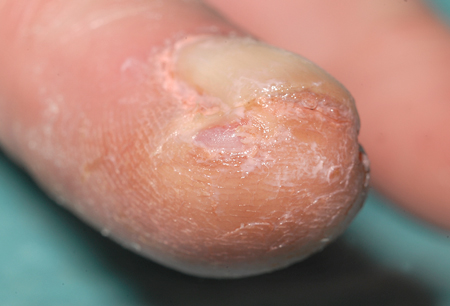History and exam
Other diagnostic factors
common
paresthesias/cold sensation/cyanosis in limb or finger
Paresthesias/cold sensation/cyanosis occur in approximately 37% of patients.[24]
ulceration/gangrene
Ulceration or gangrene on the distal phalanges may be noted. [Figure caption and citation for the preceding image starts]: Fingertip ulceration in a woman who smokesFrom the collection of Matthew J. Metcalfe and Alun H. Davies [Citation ends].
Occurs in approximately 19% of patients.[24]
claudication
Plantar claudication occurs in approximately 15% of patients, and sural claudication occurs in approximately 16% of patients.[24]
Claudication of the arch of the foot may be described by the patient.
rest pain
Occurs in approximately 10% of patients.[24]
The lower limb is often painful and can be eased by hanging the leg over the edge of the bed at night. This suggests ischemia and is not specific for Buerger disease.
superficial thrombophlebitis
A history of recurrent superficial thrombophlebitis of either the arms or legs may be given.
cold limb or finger
A cold ischemic limb or finger is present in acute ischemia. [Figure caption and citation for the preceding image starts]: A cold ischemic middle finger in a woman who smokesFrom the collection of Matthew J. Metcalfe and Alun H. Davies [Citation ends].
pale limb or finger
A pale ischemic limb or finger is present in acute ischemia.
absence of distal pulses
Popliteal pulses are present, but foot pulses are absent.
In the forearm, brachial and distal forearm pulses may be absent.
positive Allen test
Allen test may detect Buerger disease in 63% of patients.[5] Performed by occluding both radial and ulnar arteries and observing whether the patient's hand becomes ischemic. The pressure on the radial and ulnar arteries is then released 1 artery at a time. The release of each artery should reperfuse the hand individually. A negative Allen test reveals no ulnar or radial artery occlusion.
An abnormal test in a young patient is highly suggestive of Buerger disease, although may be negative in 25% of patients; a positive test in a patient with lower limb disease may indicate the presence of upper limb disease.
uncommon
joint arthritis
12.5% of patients may give a history of recurrent episodes of large joint arthritis before their arterial occlusion presentation.[25]
duration of joint symptoms up to 2 weeks
Single-joint inflammation, most often described affecting the wrists and knees, lasting up to 2 weeks. The diagnosis of Buerger disease is often not made until 10 years after the joint symptoms.
Risk factors
strong
smoking
An association with tobacco smoking has suggested a possible hypersensitivity to tobacco constituents. Less than 5% of Buerger disease patients are nonsmokers. Smoking cessation reduces amputation risk.[5] A return to smoking following cessation may lead to a flare-up of the disease. Risk of Buerger disease is thought to be increased by "bidi" (a home-made cigarette consisting of low-quality tobacco and smoked without filters) smoking, which is likely related to cannabis arteritis associated with cannabis consumption.[9][10]
Smoking only 1 or 2 cigarettes a day, using smokeless tobacco (chewing tobacco), or using nicotine replacement therapy may all keep the disease active.[19][20]
age <40 years
Buerger disease is most common in those ages <40 years. In one study, the median age of onset was 36 years.[2]
region of origin: southeast Mediterranean, Middle East, and Far East
Buerger disease is most commonly seen in people of southeast Mediterranean origin and of Middle and Far East origin.[1] It is becoming less common in Western countries.
male sex
weak
human leukocyte antigen (HLA) haplotypes
In areas of India and Japan where Buerger disease has a high prevalence, an association with HLA-DRB1*1501 has been identified.[23] However, no HLA haplotype has been associated with Buerger disease in North America.
Use of this content is subject to our disclaimer